Family : Struthionidae

Text © Dr. Gianni Olivo

English translation by Mario Beltramini
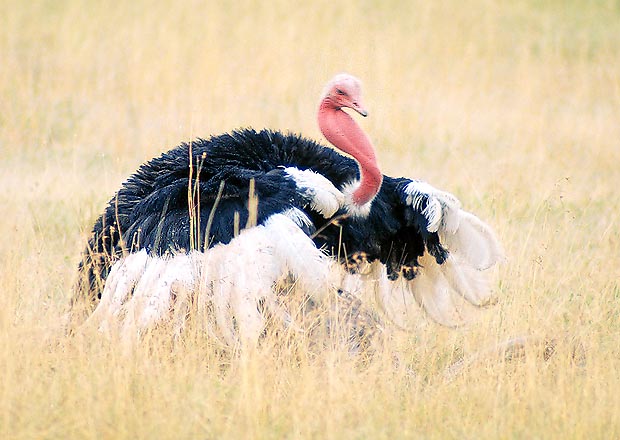
Spectacular love parade of a male of Struthio camelus © Giuseppe Mazza
The Ostrich (Struthio camelus Linnaeus, 1758) is the only member of the order of the Struthiforms and is also the biggest bird extant on Earth.
Even if exceeded, in the past and still in historical times, for what the size is concerned, by some large flightless birds, such as the moa, the ostrich, present only in the African continent, is without any doubt an animal with considerable size and weight, not only for the world of birds, but even if compared to many mammals.
A great ostrich may reach, head included, the 280 cm oh height, even if the average stands around the 220 cm, and may weigh even 150 kg, whilst the females measure usually from 180 to 200 cm per 100 or 110 kg of weight.
Perhaps not all the zoologists are in agreement, but some distinguish three subspecies of Struthio camelus, referring mainly to the fact the skin of the quite long neck, which appears bare, may assume, in the males and during the reproductive time, a bright colouring which may differ depending on the geographical areas. The Masai ostrich (Struthio camelus massaicus) tends, usually, during the courting time, to get a bright orange-pink colouration of the skin of its neck, whilst the Somali subspecies (Struthio camelus molybdophanes), present not only in Somalia, but also in northern Kenya, usually exhibits a pale blue or an azure-grey colour.

A male with favourite by their nest © Giuseppe Mazza
Finally, the Southern subspecies (Struthio camelus australis) courts the female showing a more or less lively red colour.
After my own personal experience I may say, however, of having seen individuals whose colour stood outside from these schemes, but I do not feel sure, with this, to question any classification or subdivision.
A certain sexual dimorphism does exist, apart the difference in size: the male has black plumage, with white wings and tail, whilst the female has a colouration tending to the brown or the grey and the white colour of the wings and the tail is less candid and … dirtier.
The ostrich has very soft feathers which do not have the typical stiff structure of the feathers of other species; on the other hand, being a flightless bird, such structure is not essential.
The feathers of some parts of the body are of such size and length that they may be utilized for various purposes and, especially in the past, represented an ornament in great demand by the requirements of the women’s fashion.
The limbs (specifying lower would appear obvious but, on the other hand, the wings may be considered as modified limbs) are long and bare, without any covering feathers, the thighs are extremely strong, with powerful muscles, and the paws end with a foot absolutely unique among the birds, equipped of only two toes (of which the medial one is more developed) provided with strong hooves which facilitate the grip on the dusty or little consistent grounds, thus helping the animal in sprinting and running.
The strength and the speed of the ostrich have pushed the human inventiveness to organize speed contests where reckless jockeys were riding thoroughbred “racing” ostriches in special …ostrich tracks.
Like other ratite birds, the chest wall of these animals does not have a sternum with the typical keeled structure which should furnish a joining point the strong pectorals necessary for the flight, but a flattened sternum. However, this does not mean that its wings are weak, on the contrary, they are mobile and strong and are utilized for many purposes, from the courting to the intimidation, to the utilization as help in keeping balance, and finally, also as “umbrellas”.
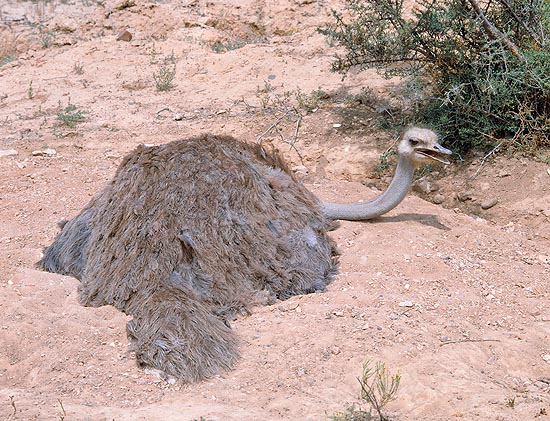
The female hatches flattened on the soil not to be seen by predators © Giuseppe Mazza
When the ambient temperatures climb to excessive levels, the bird opens the wings and channels each slightest breath of wind along the thighs, whose skin is bare, and along the lower part of the body, lowering in this way the body temperature and better dispersing the heat in excess.
Also the head is bare, but it has a thin “down” which, especially on the top, may be longer and which, in some individuals, leads to think to an odd “marine” haircut.
The eye is very big, with a diameter of even 5 cm, by sure the greatest in the kingdom of the birds, but which rivals also quite bigger animals, and this explains the excellent eyesight of the ostriches: a retina with a large surface may capture more light and a greater number of particulars.
The generously sized eyeball, the attitude to the race, the habitat, often characterized by zones with thorny trees and shrubs, might cause a serious danger to the eye and for this reason the nature has equipped it of a nictitating membrane, a sort of transparent eyelid, for protection of the visual apparatus.
The ostrich, present in good part of the African continent, loves the open and level zones and is absent in the forest, whilst it does not disdain the arid and sub-desert areas, being well equipped for the survival in these last ones.
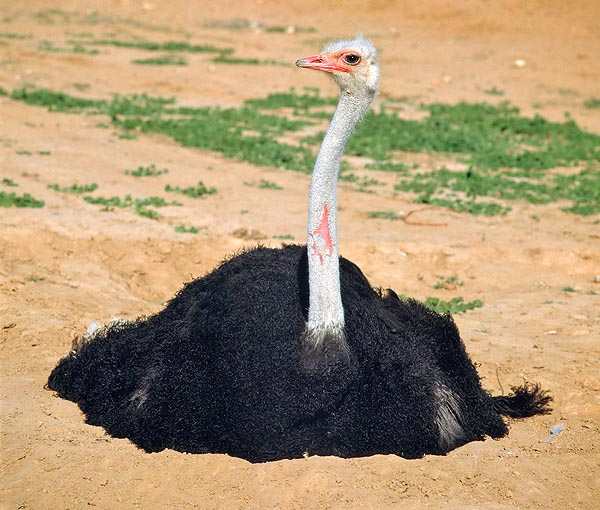
The male hatches by night. Its black plumage is mimetic and faces better the predators © Giuseppe Mazza
Like the camel and the dromedary, the ostrich is the only warm-blooded animal which does not eliminate humidity through the breath, unlike what happens to any other mammal and bird, and this is a strategy for reducing the loss of liquids. The much long neck and the hollow nostrils allow a valid cooling of the air exhaled from the lungs, and this reduces the percentage of water vapour emitted with the breathing and, consequently, the loss of liquids protecting the animal from the dehydration, risk which is present and always lurking in some habitats characterized by high temperatures and dryness.
Another feature for dispersing heat is that sort of “palpitation” of the throat which is often noticed while observing an ostrich. The area under the beak has an elastic and very rich of capillaries skin which the bird stretches like goitre, contracting and expanding it while it keeps the beak semi-open: this corresponds to the phenomenon of the “panting” which anyone may have seen in his own dog, a system which replaces the perspiration for dispersing the heat.
Long living animal, which may easily reach the 40 years of age, the ostrich is a bird tending to be gregarious and “herds” have been often observed, formed by numerous individuals, groups which may also converge in more crowded flocks, but barely stable.
It is not uncommon to see groups of these birds associated, at least on a temporary basis, to the zebras, the wildebeest or other ungulates, probably with the purpose of getting an advantage and an increment in the security, coming from the difficulty, for possible predators, do get close without being noticed by so many eyes and ears.
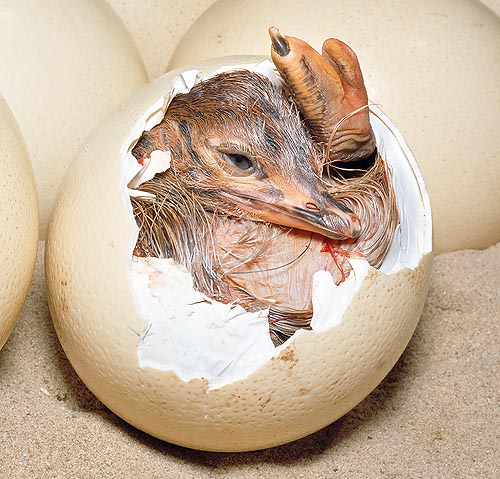
The pullets must break a solid 2 mm shell which may support a man © Giuseppe Mazza
The main defence against the predators is by sure the speed in the run: an average of 50 km per hour may be easily maintained for at least half an hour, but with peaks, if necessary, of 75 km per hour, and with a stride worthy of the seven-league boots: in this case, while I was preparing a book on the tracks of the African animals, I recorded a distance of no less than 350 cm between the footprints left by a male while running at full speed.
Nevertheless, the flight is not the only weapon at their disposal. The long and powerful legs, the size, the agility, can be chosen by an ostrich cornered by the attack, and in such case, the strong hooves, especially that of the medial toe (internal), are a formidable and possibly lethal weapon, also for big animals, as testify instances, not rare, of attacks to the man, even resulting in a fatal outcome.
Such an event is more frequent in the ostrich-farms, in the in the breeding areas, but also in natural parks and reserves, where these animals are not afraid of humans.
Often, the attacks happen due to an accidental or wanted approaching to the eggs, whilst usually, in other zones, the female would try to divert the attention of the intruder drawing him far away, often by dragging a wing and pretending to be hurt.
But there are also instances, well documented, of attacks without any apparent reason. Not far away from my reserve, in the Ben Levin natural park, a tourist was attacked while walking along a footpath: the big male of ostrich threw him on the ground skipping and then began to rage on the lying body, hoeing with full force with its legs. The man was able to save himself going under a thick shrub of thorns, was seriously hurt but at least saved himself.
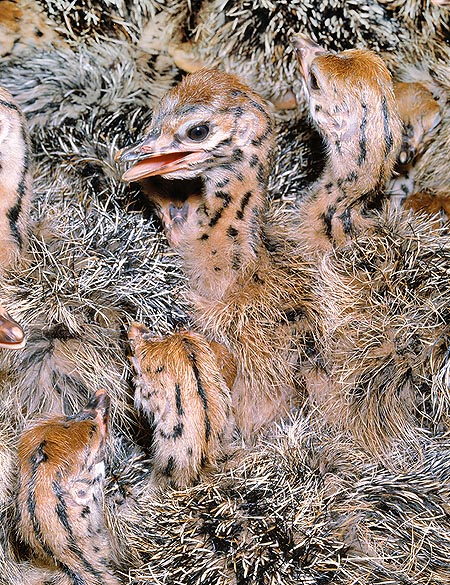
The pullets remind the prehistory with their sharp feathers © Giuseppe Mazza
An ostrich, when attacking, takes a leap up and towards the foe, then stretches the long legs and kicks violently, mowing down as if it were holding a pair of picks; these blows may easily gut an adult human or break his spine.
When attacked, if it is not possible to find a shelter like in the case of the hiker I was talking of, the only possible attempt of defence if we do not have a weapon, is to lie face down on the ground, protecting with the hands neck and head and pray that the assailant gets bored or that some one shoots it, as, otherwise, we may end up very badly.
The male, territorial, has often a harem which includes a …favourite and one or more secondary concubines, and it is not rare that more females spawn in the same “nest”.
The courting is spectacular: apart the bright colouration of the neck and of the beak exhibited by the males, these ones are quite busy in chasing and running after each other, in a frenetic sarabande, then the strongest seems to perform a real dance for attracting the attention of the female, approaching her with an “exaggerated” and stepped pace, like a consummate dancer, extending and waving its wings, twisting the neck like a corkscrew and finally literally dropping on its knees in front of the chosen lady, like a sincere lover of two centuries ago.
The reproductive system is almost unique among the birds, and for this reason the ostriches are often called “communal breeders”: the male is polygamous par excellence, as we have already seen, but there is only one favourite in the harem and only this one will hatch the eggs, in a bowl-shaped hole dug into the ground, not much deep but with a diameter of two metres, alternating with the male who, even if it is an inveterate polygamist, is not to be accused of being an idling father.
To the eggs of the First female (8 to 10 as an average), the secondary females will add their own, up to 30 or 40. Usually, those of the favourite will stand in the centre, whilst the others will be moved to the outermost part, but, in any case, the … Pompidou on duty will hatch at least a score of eggs, whilst the exceeding ones may be rejected and rolled out of the “nest” to end up as food for the hyenas or other opportunistic animals.
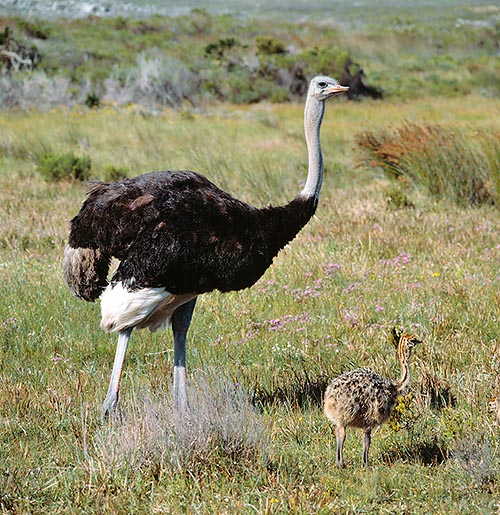
A male of Struthio camelus with young © Giuseppe Mazza
Oddly enough, in spite of being birds which nidify on the ground, their eggs are white (usually, the “ground nesters” lay cryptic coloured eggs for making it harder to the predators the finding of the eggs themselves), on the other hand, it would not be easy in any case to render unnoticed some Easter eggs weighing a kilo and a half, even is properly …camouflaged.
The eggs which have a 2 mm thick shell and are so much robust to bear the weight of a person (proved and photographed personally), weigh, rightly, from 750 to 1600 grams but, even if they are by far the most voluminous bird’s eggs, they represent only from the 1% to the 2% of the weight of the female which has laid them, whereby, if compared to its size, they are quite small (just to give an idea at the opposite extremity, the kiwi lays eggs which are a quarter of the weight of the bird).
However, the formation of such an egg inside the body of the ostrich female requires about two days, whilst in most of the birds it forms in one day or even less.
In nature, some facts, seemingly casual or attributable only to the sexual dimorphism for ritual purpose ad for courting, not to talk then about some beliefs, have, at the end, a simple and rational explanation, and the ostrich may be cited as an example, just talking of the time of hatching.
The female, of a brown or variegated grey colour, hatches the eggs during the daylight hours, flattening like a “lion’s skin” on the hole serving as a nest and this is useful for incubating the eggs as well as for hiding them: flattened on the ground, in the grass, the long neck stretched parallel to the ground in order that it does not stand out like a flag, the mother may be mistaken for a large clump of grass or for a big stone (day mimicry).
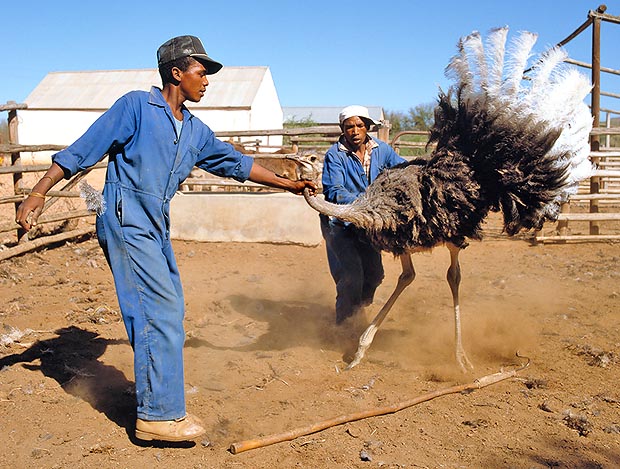
Even a tamed ostrich is not easy to catch © Giuseppe Mazza
The hatching has not only the purpose of transmitting the heat to the eggs, but, during the heat wave hours, protects them from the excessive heating, equally dangerous. There are occasions, however, when both parents leave the hatching, even if for short time, but the white colour reflects the heat and there is no risk of excessive heating under the rays of the sun. The opening of the eggs is a lengthy process and the exit is the first, tiresome and laborious, work waiting for the pullet, a real and proper struggle which, however, has a precise purpose.
During such work, the pullet literally “aspirates” into its body the yolk sac, which will be during its first 24 hours of life, the only food and source of energy.
Once I was present to the opening of the ostrich’s eggs, not in an ostrich-farm, but in full savannah, and I remained there for hours to see and take pictures. The mother tried to take me and my tracker far away from the litter (some pullets had already come out), pretending to be injured and dragging a wing. I had to stop my tracker while he was on the way of helping a pullet which was seemingly having difficulty in completing the hole in the thick shell of the egg. Touching the egg would have meant, in fact, to sentence the pullet to death.
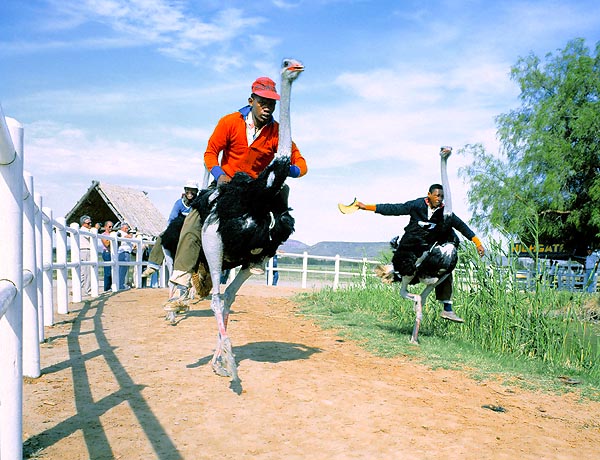
Ostrich races, with jockeys, in South Africa © Giuseppe Mazza
So much are the eggs white and visible, so much are the pullets cryptic: a brown or ochre livery, with black spots on the back and on the neck, which is not yet bare as that of the adult, camouflages them in the high grass, where they are extremely exposed to the predation, especially of the caracal, the serval, the serpents, the varans, the jackals and the hyenas.
A serious danger stands also in some birds of prey, among which, particularly, the martial eagle.
Often, both parents intervene aggressively against small and medium-sized predators, but the infant mortality is however rather high.
When they begin to nourish, the pullets are practically omnivorous and their diet includes vegetables, invertebrates, small reptilians and pebbles, which are necessary for the digestion as they act as choppers and as inner chewing apparatus. This alimentary habit is common also to the adults and is the origin of the famous saying “an ostrich stomach”.
For general information about STRUTHIONIFORMES please click here
